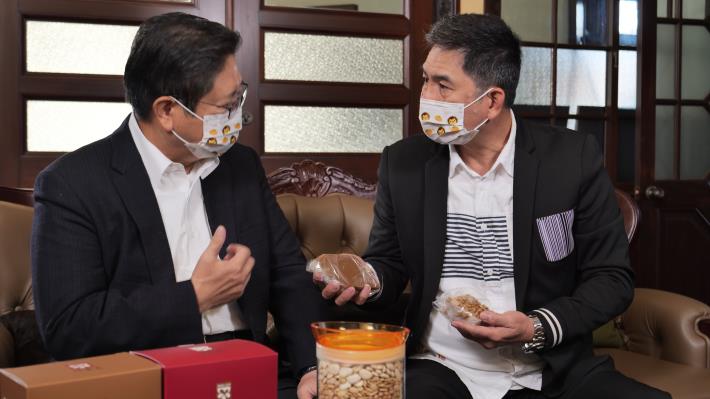
The recently popular TV drama, Gold Leaf, is inspired by Chiang A-hsin, the King of Tea in Beipu Township, Hsinchu County. The historical background is Taiwan’s tea industry in the 1950s. With the tourism buzz brought on by the drama, Magistrate Yang Wen-ke and Honduras, who played the role of Wan Shui-lai in Gold Leaf, again visited Chiang A-hsin’s western-style home under the guidance of Chiang A-hsin’s third-generation son-in-law, Wu Hsi-bin. Magistrate Yang introduced local Hakka delicacies such as Beipu puffed tea, ground tea, dry persimmon, and others. He further introduced must-visit stores and scenic spots. Honduras and other gourmands were impressed with local specialties and called for an in-depth tour of Hsinchu County
Yang Wen-ke mentioned that the puffed tea in Gold Leaf is produced in Hsinchu County’s Beipu and Emei Townships. As tea jassid suck tea sprouts, a special honey fragrance is emitted. The price for the puffed tea variety that won the outstanding award was once exceeded more than NT$1 million. Honduras was dumbfounded at hearing the price, and, as if he was acting as the greedy Gold Leaf character Boss Wang, he bargained for a lower price. “These are real gold tea leaves. How about a cheaper price?”
Yang Wen-ke expressed his gratitude to Public Television Service and the Hakka Affairs Council for jointly launching the drama Gold Leaf. Behind the show is the history of Taiwan’s local development in modern times. Yang invited Honduras to revisit Chiang A-hsin’s western-style home where the drama was finished filming. Back in the 1950s, Chiang A-hsin brought the tea industry in Beipu into prosperity, which then drove on local economic development. This building reveals Chiang A-hsin’s style. This place is worth a visit for people all around Taiwan!
Magistrate Yang noted that one can either drive or take public transportation to visit Chiang A-hsin’s western-style building at Beipu Village. For those taking public transportation, they can take the 5700 Taiwan Tourist Shuttle Shishan Line and get off at Beipu’s Old Street. The building is only a short walk away. Visitors can also take the Shishan Line to the largest Hakka market in Taiwan - Zhudong Market near the Taiwan Railway Zhudong Station, where one can taste Hakka food and snacks. The Japanese architecturally-styled Hsiao Ju-sung Art Park is also nearby. All of these places will make a wonderful artistic and culinary adventure.
Honduras said with a smile that he has little experience in Hakka culture, and he has never tried Hakka rice cakes before. Seeing that Magistrate Yang is doing his best to promote Hakka culture, food, and scenery, Honduras wished to visit Hsinchu County again for an in-depth tour!
Wu Hsi-bin, Chiang A Hsin’s third-generation son-in-law, said that the promotion by Magistrate Yang and Honduras will bring more visitors to Beipu. The building was Chiang A-hsin’s own residence and a reception place as well. Different owners then owned the property after Chiang A-hsin. It took half a century for Chiang’s family to purchase it back. The exterior of the building is in a baroque style and the interior decoration combines both Chinese and Japanese elements. It is one of only a handful of buildings in the world that harmoniously integrates Western, Chinese, and Japanese styles. The building demonstrates exquisite Hakka craftsmanship and has many unique features worth seeing.